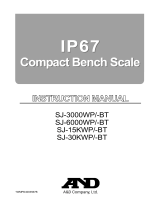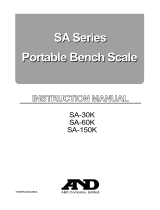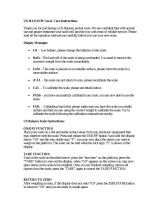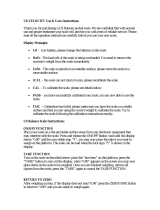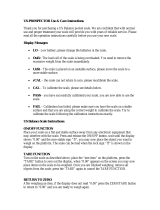Page is loading ...

Waterproof Digital Platform Scale
HV-15KCWP
HV-60KCWP
HV-200KCWP
HW-10KCWP
HW-60KCWP
HW-100KCWP
HW-200KCWP
1WMPD4003559B

This Manual and Marks
All safety messages are identified by the following, “WARNING” or “CAUTION”, of ANSI
Z535.4 (American National Standard Institute: Product Safety Signs and Labels). The
meanings are as follows:
WARNING
A potentially hazardous situation which, if not avoided, could
result in death or serious injury.
CAUTION
A potentially hazardous situation which, if not avoided, may
result in minor or moderate injury.
This is a hazard alert mark.
© 2019 A&D Company Ltd. All rights reserved.
No part of this publication may be reproduced, transmitted, transcribed, or translated into any language in
any form by any means without the written permission of A&D Company Ltd.
The contents of this manual and the specifications of the instrument covered by this manual are subject
to change for improvement without notice.
Windows, Word and Excel are registered trademarks of the Microsoft Corporation.

1
Contents
Contents .................................................................................................................................................... 1
1. Compliance ........................................................................................................................................... 3
1.1. Compliance with FCC rules ............................................................................................................ 3
1.2. Classification of Protection Provided by Enclosures ....................................................................... 3
2. Outline and Features ............................................................................................................................. 4
3. Unpacking ............................................................................................................................................. 5
4. Cautions ................................................................................................................................................ 6
4.1. Precautions for Installing the Scale ................................................................................................. 6
4.2. Precautions for Operating the Scale ............................................................................................... 6
4.3. Precautions for Storing the Scale ................................................................................................... 6
5. Installing the Scale ................................................................................................................................ 7
5.1. Setting up the Scale ........................................................................................................................ 7
5.2. Removing the Pole ......................................................................................................................... 8
5.3. Grounding the Scale ....................................................................................................................... 9
6. Part Names and Functions .................................................................................................................. 10
6.1. Display and Symbols ..................................................................................................................... 11
6.2. Keys .............................................................................................................................................. 14
7. Basic Operation ................................................................................................................................... 15
7.1. Turning the Scale ON/OFF and Weighing ..................................................................................... 15
7.2. Power on Zero Function and Power on Tare Function .................................................................. 15
7.3. Tare Function ................................................................................................................................ 16
7.3.1. How to Weigh a Tare Weight .................................................................................................. 16
7.3.2. How to Input Value of a Tare Weight with Numerical Keys (Preset Tare) ............................... 16
7.4. Switching the Mode ......................................................................................................
................ 17
8. Counting Mode .................................................................................................................................... 18
8.1. Storing a Unit Mass ...................................................................................................................... 18
8.2. Counting the Number of Articles ................................................................................................... 19
9. Accumulation Function ........................................................................................................................ 20
10. Comparator ....................................................................................................................................... 22
10.1. Setting a Mode and Method ........................................................................................................ 23
10.2. Comparison and Formula ........................................................................................................... 24
10.3. Setting Threshold Values (of Limits and Ranks) ......................................................................... 26
10.4. Buzzer Setting ............................................................................................................................ 27
11. Auto-tare Function ............................................................................................................................. 28
12. Calibration ......................................................................................................................................... 29
12.1. Calibration Procedure ................................................................................................................. 29
12.2. Calibration Using the Weight ...................................................................................................... 29

2
12.3. Setting the Gravity Acceleration .................................................................................................. 31
13. Function ............................................................................................................................................ 32
13.1. Parameter Setting Procedure ..................................................................................................... 32
13.2. Parameter List ............................................................................................................................ 33
13.3. Initializing Function Settings ....................................................................................................... 36
14. Options .............................................................................................................................................. 37
14.1. Options List ................................................................................................................................. 37
14.2. Installing the Communication Option .......................................................................................... 37
14.3. HVW-02BCWP USB Interface .................................................................................................. 38
14.3.1. Procedure for Using the USB Interface ................................................................................ 39
14.3.2. Example of Using the USB Interface .................................................................................... 39
14.4. HVW-03CWP RS-232C Interface ............................................................................................. 41
14.5. HVW-04CWP Comparator Relay Output / Buzzer .................................................................... 42
14.6. Communication Format............................................................................................................... 43
14.7. Using UFC (Universal Flex Coms) Function ............................................................................... 51
15. ID Number and GMP, GLP ................................................................................................................ 55
15.1. Setting the ID Number ................................................................................................................ 55
15.2. GMP, GLP Report ....................................................................................................................... 56
16. Maintenance ...................................................................................................................................... 61
16.1. Repair ......................................................................................................................................... 61
16.2. Check Points Before Calling Maintenance Service ..................................................................... 61
17. Specifications .................................................................................................................................... 62

3
1. Compliance
1.1. Compliance with FCC rules
Please note that this equipment generates, uses and can radiate radio frequency energy. This
equipment has been tested and has been found to comply with the limits of a Class A computing
device pursuant to Subpart J of Part 15 of FCC rules. These rules are designed to provide
reasonable protection against interference when this equipment is operated in a commercial
environment. If this unit is operated in a residential area, it might cause some interference and
under these circumstances the user would be required to take, at his own expense, whatever
measures are necessary to eliminate the interference.
(FCC = Federal Communications Commission in the U.S.A.)
1.2. Classification of Protection Provided by Enclosures
This equipment is designed to comply with the IP Code of IEC 529.
The "IP-65" code is explained as follows:
"IP" International Protection.
"6" Against ingress of solid foreign objects.
Dust-tight. No ingress of dust.
"5" Against ingress of water
Protected against water jets (no powerful jets).
Water projected in jets against the enclosure from any direction shall have no harmful
effects.

4
2. Outline and Features
□ These scales are designed to comply with IP-65 of IEC 529.
□ These scales are equipped with a weighing pan made of stainless steel (SUS304).
□ The HV-CWP series are platform scales with 1/3000 resolution, and have a triple weighing range
function to select the weighing range. The readability automatically switches to smaller interval when
a light object is weighed or larger interval when a heavy object is weighed, depending on the weight
of the object (multi-interval).
□ The HW-CWP series is made up of platform scales with 1/10000 resolution.
□ The scales use a backlit liquid crystal display to enable viewing in dim light.
□ Using the optional RS-232C serial interface or USB interface, data can be output to a printer. Also,
the weighing value can be output, the scale can be controlled or the setting value can be set by a
command from a personal computer.
□ The counting mode converts the total mass value (total weight) of articles to a count when each
article has the same mass value.
□ The scales have an accumulation function with a maximum of 6 digits, which can accumulate up to
999 times (The number of times weighed and the total mass value of that can be stored in the scale).
□ The comparator function compares the displayed weighing value against preset limit values and
displays the result. The comparison result can be output if the optional HVW-04CWP is installed on
the scale.
□ The following parameters are stored in the scale even if the power is turned off.
Unit mass of counting mode
Total count and total mass of accumulation function
Preset limit values of comparator function
Calibration data
Parameters of the function table
□ Multi-interval :
The readability (scale interval or "individual or "division") is automatically switched depending on the
weight of an object to be measured.
Example : The HV-60KCWP with 60kg weighing capacity and 0.005kg, 0.01kg or 0.02kg
readability. The readability is automatically switched when the small, medium
or large range is exceeded.
Point : When a lighter object is weighed, the readability becomes finer. When a
heavier object is weighed, the readability becomes coarser.
60kg
0.005kg
15kg
30kg
0.02kg0.01kg
Small
range
Large
range
Medium
range
Weighing capacity
Minimum
display
Readability

5
3. Unpacking
HV-15KCWP HV-60KCWP
HW-10KCWP HW-60KCWP
HV-200KCWP
HW-100KCWP
HW-200KCWP
Models Accessories
HV-15KCWP,
HW-10KCWP
Instruction Manual
HV-60KCWP, HW-60KCWP,
HW-100KCWP,
HV-200KCWP, HW-200KCWP
3mm Hex Wrench
Instruction Manual
Accessories
3mm Hex Wrench
Instruction Manual
Display Unit
Display Unit
Weighing Pan
(
SUS304
)
Base Unit
Base Unit
Base Unit
Display Unit
Main Power Cord
CAUTION
Do not pull the load cell cable.
Main Power Cord
Main Power Cord
Main Power
Please confirm that the local voltage and
the receptacle type are correct for your
scale.
Weighing Pan
(
SUS304
)
Weighing Pan
(
SUS304
)
CAUTION
Do not pull the load cell cable.

6
4. Cautions
4.1. Precautions for Installing the Scale
Consider the following conditions to get the most from your scale.
Install the scale on a solid and level surface where the temperature and relative humidity is stable, there
is no draft and a stable power source is available.
Do not install the scale on a soft floor or where there is vibration.
Do not install the scale near heaters or air conditioners.
Do not install the scale in direct sunlight.
Do not install the scale near equipment that produces strong magnetic fields.
Do not install the scale where static electricity is likely to occur. When the relative humidity is lower
than 45%R.H., plastic and isolators are apt to be charged with static electricity.
Do not use an unstable power source.
Remove the protective film from the weighing pan before use.
The scale must be used indoors only. Using the scale outdoors may expose the scale to lightning
surge beyond its withstand current rating. In such a case, the scale may incur machanical
damages as it cannot withstand lightning energy.
4.2. Precautions for Operating the Scale
Do not place anything on the weighing pan that exceeds the weighing capacity.
Do not drop anything on the weighing pan.
Do not use a sharp instrument such as a pencil or ball-point pen to press the switches. Press the
switches gently using only your finger.
Pressing the ZERO key before each weighing to prevent possible error.
Weighing must not be done with the scale in water.
Periodically ensure that the weighing value is correct.
Close the calibration switch cover and the display rear cover to keep waterproof.
Calibrate the scale when it is initially installed and after it is moved to another location.
4.3. Precautions for Storing the Scale
Do not disassemble the scale.
Do not use solvents to clean the scale.
For best cleaning of the display unit, wipe with a dry lint-free cloth or a lint-free cloth moistened
with water and a mild detergent.
Do not scratch the base unit with a brush.
Do not use a powerful water jet.
WARNING
Ground the scale, so that the user will not be subjected to an electric shock.
Do not handle the main power cord with wet hands.
The AC plug is not water-resistant. Install it in an area where it does not get wet.
Do not install the scale where there is flammable or corrosive gas present.
Do not pull, fold or arrange cables forcibly.
The scale is heavy, so handle it with care when transporting.
The scale must be transported by holding the base as holding the pole may cause
the scale to fall.

7
5. Installing the Scale
5.1. Setting up the Scale
The following procedure describes general steps for installing the scale. Some steps may not be required
for some models or in some cases.
Step 1 Take the base unit and the pole out of the packing box
while being careful not to pull the load cell cable.
Step 2 Put the weighing pan on the base unit.
Remove the protective film from the pan before use.
Step 3 While being careful not to harm the load cell cable,
insert the pole into the bracket of the base unit, with
the excess load cell cable tucked inside the pole.
Secure the pole to the bracket with the two provided
hex screws using the 3 mm hex wrench.
* This step is not required for HV-15KCWP or
HW-10KCWP because the pole and bracket
are provided as a combined unit.
Step 4 Decide where to install the scale by considering the
descriptions of "4.1. Precautions for Installing the
Scale".
Step 5 Level the base unit by adjusting the four leveling feet
of the base unit so that the bubble of the spirit level is
centered, and then adjust the pole foot beneath the
pole to stand on the floor.
Step 6 Ground the scale using the earth terminal in order to
prevent electric shock.
CAUTION
Please confirm that the local voltage and the receptacle
type are correct for your scale.
Step 7 Adjust the angle of the display unit using the knobs
on the right and left sides.
Step 8 Check the weighing accuracy. If necessary, perform
calibration so that the scale can weigh accurately.
For calibrating the scale, refer to "12. Calibration".
Weighing Pan
Step 2
Step 1
Load Cell
Cable
Pole
Base Unit
Pole
3 mm Hex Wrench
Step 3
Hex Screws
Bracket
Step 5
OK: Level NG: Inclination
Leveling Feet
Knob
Step 7
Earth
Earth Terminal
Power Terminal
Bubble Spirit Level
Pole Foot
The rear
of
Display
Uni
t

8
5.2. Removing the Pole
CAUTION
Do not pull the load cell cable. Do not bend the load cell cable forcibly.
Take care that the load cell cable does not touch the weighing pan inside the base unit.
Avoid dust, static electricity and high humidity (or condensation) because
the inside of the display unit is sensitive to those.
Step 1 Remove the main power plug from the receptacle.
Step 2 Open the load cell panel in the rear of the display unit.
Remove the load cell cable connected to the terminal
using a flat-head screwdriver.
Step 3 Unfasten the two knobs fastening the display and the pole.
Step 4 Remove the four 3mm screws from the bottom cover of
the bracket using a Phillips screwdriver.
Step 5 Carefully remove the load cell cable from the pole.
Be careful not to pull the cable forcibly.
Step 6 Fix the cable so it does not touch to the weighing pan
in the base unit.
If the cable is untied, the straight length of 10K/15K models
is approximately 1.5 m, and the straight length of the other
models is approximately 2.5 m.
WARNING
Turn off the scale and remove the main power plug from the receptacle before removing
the pole.
Knob
Bracket (Middle / Large Size)
Pole
Bottom Cover
3mm Screws
Red :EXC+
White :EXC–
Green :SIG+
Blue :SIG–
Yellow :SHIELD
Load Cell Panel
Terminal Block

9
Step 7 To remove the bracket from the base unit, use a hex wrench.
For HV-15KCWP, HV-60KCWP,
HW-10KCWP, HW-60KCWP
For HV-200KCWP,
HW-100KCWP, HW-200KCWP
5mm Hex Wrench 6mm Hex Wrench
Step 8 Connect the load cell cable to the terminal of the display unit.
Step 9 Close the load cell panel.
Step 10 Check the weighing accuracy.
* The installation example is when the optional indicator
holder (AX-043005266) is used after the pole is
removed.
5.3. Grounding the Scale
When using where there may be static electricity, ground the scale.
The grounding method differs depending on the model.
Ground the scale properly according to the model.
Method-A procedure to ground the scale
(HV-15KCWP, HW-10KCWP)
Secure the grounding wire using an M4 screw in the screw
hole between the two hexagon bolts on the base unit
bottom side (Part “ ”).
Method-B procedure to ground the scale
(HV-60KCWP, HV-200KCWP,
HW-60KCWP, HW-100KCWP, HW-200KCWP)
Secure the grounding wire together with the screw that
secures the bottom cover (Part “ ”).
Hex Bolts
Hex Wrench
Bracket
Bottom of
Base Unit
Bottom Cover
Indicator Holder
(To be purchased separately as an option)
Bottom of
Base Unit
Leveling Foot

10
Pole
Foot
Bubble
Spirit Level
6. Part Names and Functions
HV-15KCWP HV-60KCWP
HW-10KCWP HV-200KCWP
HW-60KCWP
HW-100KCWP
HW-200KCWP
Display Unit
The Rear of the Display Unit
水平 傾斜
Display
Unit
Knobs
Pole
Weighing Pan
(SUS304)
Base Unit
Leveling Feet
Leveling
Feet
Main Power Cord
Power Terminal
Earth Terminal
Option Panel (CH2)
Option Panel (CH1)
Load Cell Panel
Knob for Angle Adjustment
To reveal the terminal and CAL switch, open
the load cell panel.
Calibrate the scale to weigh correctly.
Use the proper OIML class calibration mass.
Keys
Weighing Condition
Comparator
Weighing Data
Weighing Unit
Conditions for
Each Function
Rating Label
Serial Number
Level Inclination
Display
Unit

11
6.1. Display and Symbols
Display and Symbols Description
Stability indicator
When the current weighing value is stable, this indicator is
displayed. It means the scale is in the proper condition for reading
weighing values.
Zero point indicator
The zero point is the reference point for weighing.
When the ZERO key is pressed with nothing on the weighing pan,
this indicator and a zero value are displayed.
Net indicator
When the TARE key is pressed and a tare weight is taken away,
this indicator is displayed. The tare weight (the weight of a
container, etc.) is a value to be subtracted from the gross value.
Preset tare indicator
This indicator is displayed while a digitally input tare is used.
Hold indicator
This indicator is displayed while the display is held.
Accumulation indicator
This indicator is displayed while the accumulation function is
used.
Comparator indicator
While the comparator function is being used, the weighing value
is compared using the preset threshold values and the indicator
displays the result.
Example: Zero point (the reference point for weighing)
When the ZERO key is pressed with nothing on the weighing pan,
the zero value, the zero point indicator and stability indicator are
displayed.
Example: Counting mode
This mode counts the number of articles on the weighing pan
using the preset unit mass.
Example: Storing the unit mass for the counting mode
The unit mass is stored using 20 samples.
The zero value means that no articles are on the weighing pan.
HOLD
PT
M+
STABLE
ZERO
Weighed mass value
unit

12
Example
PT
Example: Storing the unit mass of the counting mode
The unit mass is stored using10 samples.
Sign "-" means that something is placed on the weighing pan..
Example: Function settings
Select the item using the MODE key and enter it using the
ENTER key.
Input a parameter using the numerical keys.
Store the parameter using the ENTER key.
Example: While setting preset tare
Input a tare value using the numerical keys.
Store the value using the ENTER key.
Example: Hold display
The hold display is set using Hold of the function table.
When the weighing value is near zero (within the zero band) or
changes more than 25% +30 digits, the hold is canceled.
This error occurs when the mass sensor receives a strong force in
the upward direction.
Please check if the weighing pan is caught in something or
foreign matter is not entering the base part. There is a possibility
that the mass sensor or internal circuit has failed.
Overload display
Remove anything that is on the weighing pan.
Calibration Error
Please check if the weighing pan is properly placed or the weight
is too light and try again.
Calibration Error
Please check if the weighing pan is properly placed or the weight
is too heavy and try again.
This is an error where the zero value cannot be displayed when
the display is turned on. Please remove the items on the weighing
pan. If calibration is necessary, perform "Calibration of the Zero
Point" in "12.2. Calibration Using the Weight".
Or, this is an error where the weighing value is not stabilized
when the display is turned on. Avoid a breeze or vibration and
check whether the weighing pan is touching something.
Parameter
Item
HOLD

13
and lighting up
Blinking
M+
Blinking
M+
Display and Symbols Description
Accumulated data count.
Total mass value of the accumulated data.
Example: Capacity and readability
Max 3 / 6 / 15 kg
d= 0.001 / 0.002 / 0.005 kg
The weighing range and measurable minimum mass
.
Examples:
Displays the weighing value in increments of 0.001 kg (1 g) up to 3 kg.
Displays the weighing value
in increments of
0.002 kg (2 g) up to 6 kg.
Displays the weighing value in increments of 0.005 kg (5 g) up to 15 kg.
Alternating current.
Earth (ground) Terminal.

14
6.2. Keys
Keys Description
ON/OFF Key
Shows or hides the display alternately.
Note: When the main power plug of the scale is connected to the receptacle,
the power is supplied to the electric circuit inside the scale.
ZERO Key
Based on the zero point weighed at the time of turning on the display (Power
on zero function), by pressing the ZERO key when the weight value is stable
within ±2% of the weighing capacity, the zero point indicator turns on as soon
as the display becomes zero.
At this time, if tare function is used, the tare value is deleted.
If accumulation data is displayed, the accumulation count and value are
deleted.
TARE Key
By pressing the TARE key when the weighing value is a positive and stable
value, the weight of the item on the weighing pan is subtracted as the weight
of a container (tare weight), and a zero value and both the zero point and net
indicators are displayed. (Tare function)
Note: The weighing range is reduced according to value of the tare weight.
M+ Key
Adds to the accumulated data.
SET Key
Selects + and - for limit values in the comparator mode.
Press
and and
hold press
Use these keys to enter the preset tare setting mode.
Press
and and
hold press
Use these keys to display the accumulated results.
Press
and and
hold press
Use theses keys to set limit values for the comparator.
MODE Key
Switches the weighing unit to be displayed.
This key is used to select the items at each setting.
HOLD Key
Holds the display. (Refer to “13. Function” for details)
PRINT Key
Outputs the displayed weighing data. (Refer to “13. Function” for details)
Display off
Press
and and
hold press
Use these keys to enter the function mode.

15
7. Basic Operation
7.1. Turning the Scale ON/OFF and Weighing
Step 1 Ground the scale using the earth terminal.
Step 2 Confirm that nothing is placed on the weighing pan.
Step 3 Confirm that local voltage and receptacle type are correct before connecting the scale.
Step 4 The scale is turned on or off using the ON/OFF key.
Step 5 Check the accuracy of weighing.
Allow a 30-minute warm up period before calibration
Step 6 With nothing on the weighing pan, press the ZERO key to display the zero value.
Step 7 Gently place an article to be weighed on the weighing pan.
Step 8 Wait for the stability indicator to be displayed, then read the weighing value.
Step 9 Gently remove the article from the weighing pan.
Step 10 Turn off the display using the ON/OFF key.
Note
When the display is turned off by pressing the ON/OFF key, the power is still being supplied
inside the circuit of the scale. To shut off the power completely, disconnect the power cord of
the scale from the receptacle.
Please confirm that the local voltage and the receptacle type are correct for your scale.
7.2. Power on Zero Function and Power on Tare Function
Power on Zero Function:
When nothing is placed on the weighing pan and the scale is turned on using the ON/OFF key, the
weighing value is assumed as the reference value of weighing. The zero value as gross value and
zero point indicator are displayed. The power on zero function can be used when the weighing value
is within the threshold value from the zero point at calibration.
Main Power Cord
Power Terminal
Earth Terminal
Stability Indicator
Zero Point Indicator
ON/OFF Key
ZERO Key

16
Power on Tare Function:
When a tare weight (container) is placed on the weighing pan and the scale is turned on using the
ON/OFF key, the tare function is performed and a zero value is displayed as net value. Zero point
indicator and net indicator are displayed. The power on tare function can be used when the current
zero point is more than the threshold value from the zero point of calibration.
Active function
Threshold value
Principal standard models Approved models
Power on zero function
±50 % of capacity ±10 % of capacity
Power on tare function
+50 % of capacity +10 % of capacity
7.3. Tare Function
The tare function is used when weighing an article in a container to display only the mass of the content
(net weight) by subtracting the mass of the container (tare weight).
CAUTION
The weighing range is reduced according to the value of the tare weight.
The current net value is reset to zero value when the ZERO key is pressed or the
display is turned off.
The storable preset tare value is within the minimum weighing range
7.3.1. How to Weigh a Tare Weight
Step 1 Place the container on the weighing pan.
Step 2 Wait for the stability indicator to be displayed, then press the TARE key.
The display becomes zero value.
Step 3 Place an article to be weighed into the container.
Wait for the stability indicator to be displayed, and then read the value.
Step 4 Remove all of the articles and the container from the weighing pan.
7.3.2. How to Input Value of a Tare Weight with Numerical Keys (Preset Tare)
Step 1 While pressing and holding the SET key, press the TARE key.
The scale displays a blank display or the stored tare value. A blank display means that the tare
value is zero (reset value). And PT blinks.
Step 2 Input the preset tare value using the numerical keys.
Step 3 Press the ENTER key to store the new preset tare value.
The scale displays the net value as preset tare value subtracted from gross value.
Step 4 Place an article to be weighed into the container.

17
Wait for the stability indicator to be displayed, and then read the value.
Step 5 Remove all of the articles and the container from the weighing pan.
7.4. Switching the Mode
*1
*1 The weighing unit used when turned on is the last weighing unit used before turning off.
*2 When accumulation data is stored in the scale, the number of accumulations and an accumulation
value can be displayed.
*3 The lb-oz display is only available with HV-15KCWP and HW-10KCWP.

18
8. Counting Mode
The counting mode is the function to convert the total mass value (total weight) of articles to a count,
when each article has the same mass value.
To use this function, store a unit mass in advance.
Even if the power is turned off, the unit mass is maintained in non-volatile memory.
8.1. Storing a Unit Mass
Step 1 Press the MODE key to display the unit pcs.
Step 2 Press the ENTER key while pressing and holding the
SET key to enter the mode for storing a unit mass.
Step 3 Press the SET key to select the number of samples:
5 pieces, 10 pieces, 20 pieces, 50 pieces or 100 pieces.
The greater the quantity of samples, the greater the
accuracy of the count.
Step 4 Place the container on the weighing pan.
Press the TARE key.
Step 5 Place the number of samples selected at Step 3.
After the stability indicator is displayed, press the
ENTER key to store it.
CAUTION
When the sample total mass value is too small and it is not
possible to calculate a unit mass, the scale displays lo ut
and returns to step 3. Increase the number of samples. The total
sample mass are required more than 10 times of readability in
kg.
When the unit mass is too small to store, the scale displays
1 lo ut . . In this case, the unit mass will not be stored even
if the number of samples is increased.
To return to the weighing mode, press the MODE key.
Step 6 The count is displayed.
Step 7 Remove the samples and the container from the weighing pan.
/
